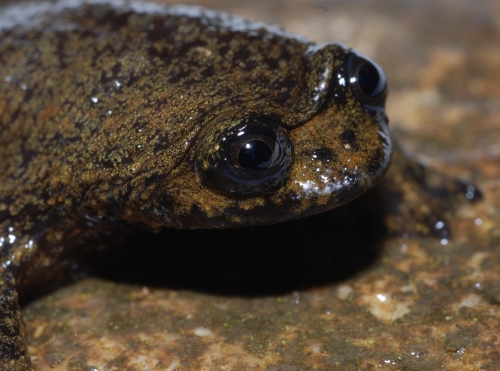The Bornean flat-headed frog, once believed to be the world’s only lungless frog species, has been found to actually possess small, thin lungs. Initial research concluded that the species was lungless due to its oxygen-rich aquatic environment. However, recent advancements in technology, specifically high-resolution micro-CT scanning, debunked this myth, revealing a respiratory system with visible lungs. This groundbreaking discovery raises questions about the evolution of respiratory systems in aquatic frogs and highlights the importance of advanced technology in scientific research. Further exploration is necessary to uncover the complexities of this finding and its implications for the scientific community.
Frog Species Characteristics Revealed
One of the most fascinating aspects of the Bornean flat-headed frog is its unique set of characteristics that enable it to thrive in its aquatic environment.
Found exclusively in Borneo, this rare species inhabits cold and fast-flowing streams, where oxygen-rich rivers provide an ideal habitat.
The frog’s body is adapted to its aquatic environment, with features that allow it to navigate and survive in its aquatic home. The Bornean flat-headed frog is fully aquatic, a trait that sets it apart from other frog species.
Its habitat is characterized by strong currents, which require specialized adaptations to thrive.
The frog’s unique characteristics have sparked scientific interest, driving researchers to investigate its anatomy and physiology.
Understanding the adaptations of the Bornean flat-headed frog can provide valuable insights into the evolution of aquatic frogs and their ability to thrive in challenging environments.
Research and Discovery Timeline
Researchers have been fascinated by the Bornean flat-headed frog‘s unique characteristics, leading to a series of investigations that have substantially advanced our understanding of this species.
In 2008, a team led by David Bickford conducted a pioneering study, dissecting 11 specimens to explore the frog’s anatomy. The researchers were unable to locate lungs, leading them to conclude that the species was lungless, an adaptation to its oxygen-rich aquatic environment.
This finding sparked interest in the scientific community, with many accepting the lungless hypothesis. However, recent advancements in technology enabled a re-examination of the initial findings.
David Blackburn and colleagues utilized high-resolution micro-CT scanning to re-examine two of Bickford’s specimens, revealing a respiratory system with small, thin lungs.
This groundbreaking discovery has rewritten our understanding of the Bornean flat-headed frog’s anatomy, highlighting the importance of continued research and the value of re-examining previous findings with new technologies.
Debunking the Lungless Myth
The re-examination of the Bornean flat-headed frog‘s anatomy using advanced micro-CT scanning technology has conclusively debunked the long-held myth that this species is lungless.
The initial research, conducted in 2008, led by David Bickford, concluded that the frog was lungless, with the assumption that large lungs would make them more buoyant and susceptible to strong currents in their aquatic habitat.
However, the re-examination of two specimens using high-resolution micro-CT scanning technology revealed a respiratory system with small, thin lungs. The glottis, where the mouth connects with the lungs, was visible, contradicting the initial conclusion of lunglessness.
The discovery of lungs in the Bornean flat-headed frog is significant, as it challenges our understanding of the species’ adaptation to its aquatic environment.
The finding raises questions about the evolution of lungs in aquatic frogs and highlights the importance of advanced technology in scientific research.
The previous notion that the frog relied solely on skin respiration is now disputed, and a more nuanced understanding of the species’ respiratory system is emerging.
Broader Context and Significance
Cutting-edge technological advancements have revolutionized the scientific landscape, affording unprecedented opportunities for the exploration of complex biological systems.
The discovery of lungs in the Bornean flat-headed frog serves as a prime example, highlighting the significance of advanced technology in scientific research. The study demonstrates the value of re-examining previous research with new technology, leading to a deeper understanding of amphibian anatomy and evolution.
This finding has broader implications for the scientific community, as it raises questions about the respiratory systems of other aquatic animals.
The discovery could lead to a re-evaluation of the respiratory systems of these animals, potentially uncovering new insights into their evolution and adaptation to their environments.
In addition, this study showcases the importance of collaboration and the need for ongoing research in understanding the complexities of biological systems.
As scientists, it is essential to remain open to new findings and to continually refine our understanding of the natural world.

Erzsebet Frey (Eli Frey) is an ecologist and online entrepreneur with a Master of Science in Ecology from the University of Belgrade. Originally from Serbia, she has lived in Sri Lanka since 2017. Eli has worked internationally in countries like Oman, Brazil, Germany, and Sri Lanka. In 2018, she expanded into SEO and blogging, completing courses from UC Davis and Edinburgh. Eli has founded multiple websites focused on biology, ecology, environmental science, sustainable and simple living, and outdoor activities. She enjoys creating nature and simple living videos on YouTube and participates in speleology, diving, and hiking.
- WILDLIFE THEMED T-SHIRTS
Cute Hedgehog Embroidered: Love Wildlife, Protect Nature Wildlife conservation tees
$35.00







